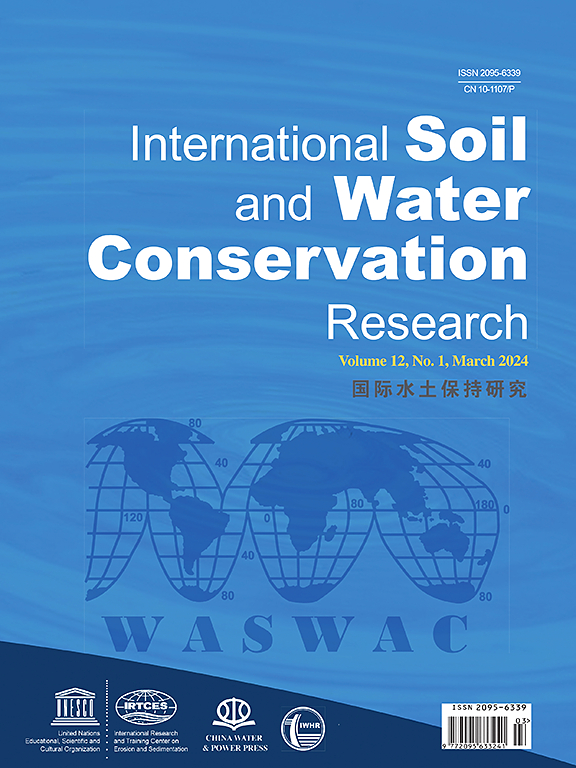A data-driven impact evaluation of nutrient input reduction on wheat yields across Europe
IF 7.3
1区 农林科学
Q1 ENVIRONMENTAL SCIENCES
International Soil and Water Conservation Research
Pub Date : 2025-07-28
DOI:10.1016/j.iswcr.2025.07.012
引用次数: 0
Abstract
The European Union (EU) is one of the largest cereal producers in the world, with wheat covering around one-third of its agricultural area. Sustainable soil management has been put as a key point of EU Green Deal policies, with concrete measures to reduce fertilizer application by 2030. However, uncertainty still exists about the expected impact of such a reduction on wheat yield across the EU. In this work, we construct a regression model to evaluate the possible impacts of fertilizer reduction and climate change on wheat yields by 2050. The regression model quantifies the effects of soil properties, soil management, and climate on wheat yields at the EU scale. In addition, we simulate two scenarios, one based on the EU fertilizer targets only and the other focusing on climate change impact (+4 °C). The results show an important effect of soil phosphorus, nitrogen, and potassium content, soil carbon-to-nitrogen ratio, and nitrogen inputs on the variation in wheat yields across the EU, next to climate. The scenario analysis suggests that reducing N and P inputs by 20 % leads to wheat yield losses of up to 5 %, an effect that can rise to 50 % yield reduction by 2050 under climate change. Fertilizer reduction leads to most significant yield decreases in France, Germany and Northern Italy, while climate change reduces yields mostly in Southern Europe. Beyond highlighting relevant regional patterns, our results show how EU fertilizer reduction targets are expected to have a small impact on wheat production compared to climate change.
数据驱动的养分投入减少对整个欧洲小麦产量的影响评估
欧盟(EU)是世界上最大的谷物生产国之一,小麦约占其农业面积的三分之一。可持续土壤管理已被列为欧盟绿色协议政策的重点,并提出了到2030年减少化肥施用的具体措施。然而,这种减产对整个欧盟小麦产量的预期影响仍然存在不确定性。在这项工作中,我们构建了一个回归模型来评估到2050年化肥减量和气候变化对小麦产量的可能影响。回归模型量化了土壤性质、土壤管理和气候对欧盟范围内小麦产量的影响。此外,我们还模拟了两种情景,一种仅基于欧盟肥料目标,另一种侧重于气候变化影响(+4°C)。结果表明,土壤磷、氮、钾含量、土壤碳氮比和氮投入对整个欧盟小麦产量的变化具有重要影响,仅次于气候。情景分析表明,减少20%的氮磷投入会导致小麦产量损失高达5%,在气候变化的影响下,到2050年,这一影响可能会增加到减产50%。减肥导致法国、德国和意大利北部的产量下降最为显著,而气候变化导致的产量下降主要发生在南欧。除了突出相关的区域模式外,我们的研究结果表明,与气候变化相比,欧盟减肥目标预计对小麦产量的影响很小。
本文章由计算机程序翻译,如有差异,请以英文原文为准。
求助全文
约1分钟内获得全文
求助全文
来源期刊

International Soil and Water Conservation Research
Agricultural and Biological Sciences-Agronomy and Crop Science
CiteScore
12.00
自引率
3.10%
发文量
171
审稿时长
49 days
期刊介绍:
The International Soil and Water Conservation Research (ISWCR), the official journal of World Association of Soil and Water Conservation (WASWAC) http://www.waswac.org, is a multidisciplinary journal of soil and water conservation research, practice, policy, and perspectives. It aims to disseminate new knowledge and promote the practice of soil and water conservation.
The scope of International Soil and Water Conservation Research includes research, strategies, and technologies for prediction, prevention, and protection of soil and water resources. It deals with identification, characterization, and modeling; dynamic monitoring and evaluation; assessment and management of conservation practice and creation and implementation of quality standards.
Examples of appropriate topical areas include (but are not limited to):
• Conservation models, tools, and technologies
• Conservation agricultural
• Soil health resources, indicators, assessment, and management
• Land degradation
• Sustainable development
• Soil erosion and its control
• Soil erosion processes
• Water resources assessment and management
• Watershed management
• Soil erosion models
• Literature review on topics related soil and water conservation research
 求助内容:
求助内容: 应助结果提醒方式:
应助结果提醒方式:


